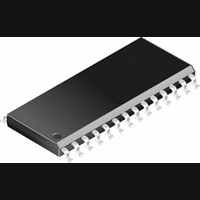CS8415A-CS Cirrus Logic Inc, CS8415A-CS Datasheet - Page 35

CS8415A-CS
Manufacturer Part Number
CS8415A-CS
Description
IC, DIGITAL AUDIO RECEIVER, SOIC-28
Manufacturer
Cirrus Logic Inc
Specifications of CS8415A-CS
Audio Control Type
Digital
Control Interface
I2C, Serial
Control / Process Application
AV & DVD Receivers, CD-R, Digital Mixing Consoles
Supply Voltage Range
2.85V To 5.5V
Lead Free Status / RoHS Status
Contains lead / RoHS non-compliant
Available stocks
Company
Part Number
Manufacturer
Quantity
Price
Part Number:
CS8415A-CS
Manufacturer:
CIRRUS
Quantity:
20 000
Company:
Part Number:
CS8415A-CSR
Manufacturer:
CirrusLogic
Quantity:
569
Company:
Part Number:
CS8415A-CSZ
Manufacturer:
CIRRUS
Quantity:
108
Part Number:
CS8415A-CSZ
Manufacturer:
CRYSTAL
Quantity:
20 000
12. APPLICATIONS
12.1 Reset, Power Down and Start-up
When RST is low, the CS8415A enters a low pow-
er mode and all internal states are reset, including
the control port and registers, and the outputs are
muted. When RST is high, the control port be-
comes operational and the desired settings should
be loaded into the control registers. Writing a 1 to
the RUN bit will then cause the part to leave the
low power state and begin operation. After the PLL
has settled, the serial audio outputs will be enabled.
Some options within the CS8415A are controlled
by a start-up mechanism. During the reset state,
some of the output pins are reconfigured internally
to be inputs. Immediately upon exiting the reset
state, the level of these pins is sensed. The pins are
then switched to be outputs. This mechanism al-
lows output pins to be used to set alternative modes
in the CS8415A by connecting a 47 KΩ resistor to
between the pin and either VL+ (HI) or DGND
(LO). For each mode, every start-up option select
pin MUST have an external pull-up or pull-down
resistor. In software mode, the only start-up option
pin is EMPH, which is used to set a chip address bit
for the control port in Two-Wire mode. The hard-
ware mode uses many start-up options, which are
detailed in the hardware definition section at the
end of this data sheet.
12.2 ID Code and Revision Code
The CS8415A has a register that contains a 4-bit
code to indicate that the addressed device is a
CS8415A. This is useful when other CS84XX fam-
ily members are resident in the same system, allow-
ing common software modules.
The CS8415A 4-bit revision code is also available.
This allows the software driver for the CS8415A to
identify which revision of the device is in a partic-
DS470PP3
ular system, and modify its behavior accordingly.
To allow for future revisions, it is strongly recom-
mend that the revision code is read into a variable
area within the microcontroller, and used wherever
appropriate as revision details become known.
12.3 Power Supply, Grounding, and PCB
For most applications, the CS8415A can be operat-
ed from a single +5 V supply, following normal
supply decoupling practices, see Figure 5. For ap-
plications where the recovered input clock, output
on the RMCK pin, is required to be low jitter, then
use a separate, quiet, analog +5 V supply for VA+,
decoupled to AGND. In addition, a separate region
of analog ground plane around the FILT, AGND,
VA+, RXP0-6 and RXN0 pins is recommended.
Extensive use of power and ground planes, ground
plane fill in unused areas and surface mount decou-
pling capacitors are recommended. Decoupling ca-
pacitors should be mounted on the same side of the
board as the CS8415A to minimize inductance ef-
fects, and all decoupling capacitors should be as
close to the CS8415A as possible.
layout
CS8415A
35

















